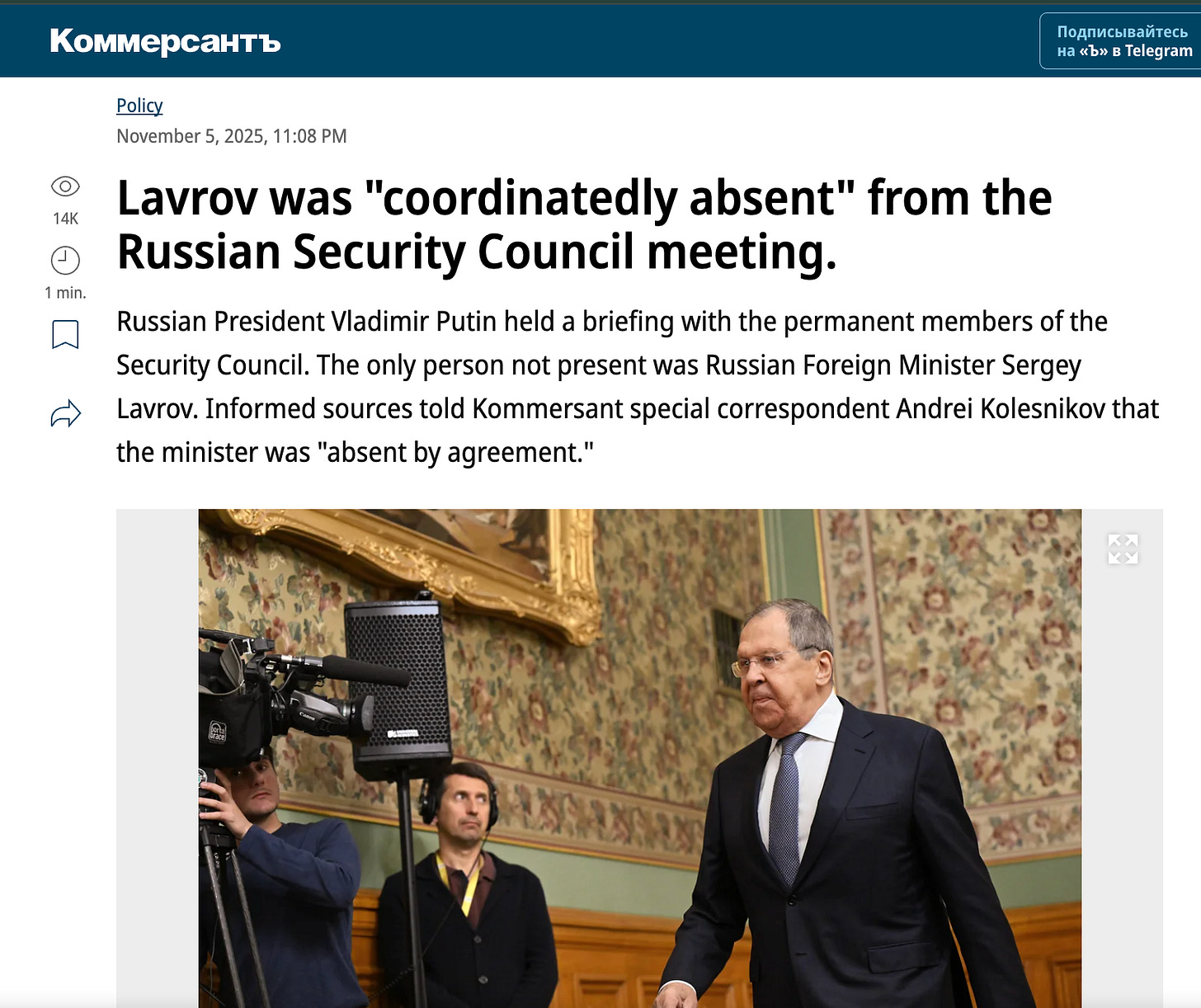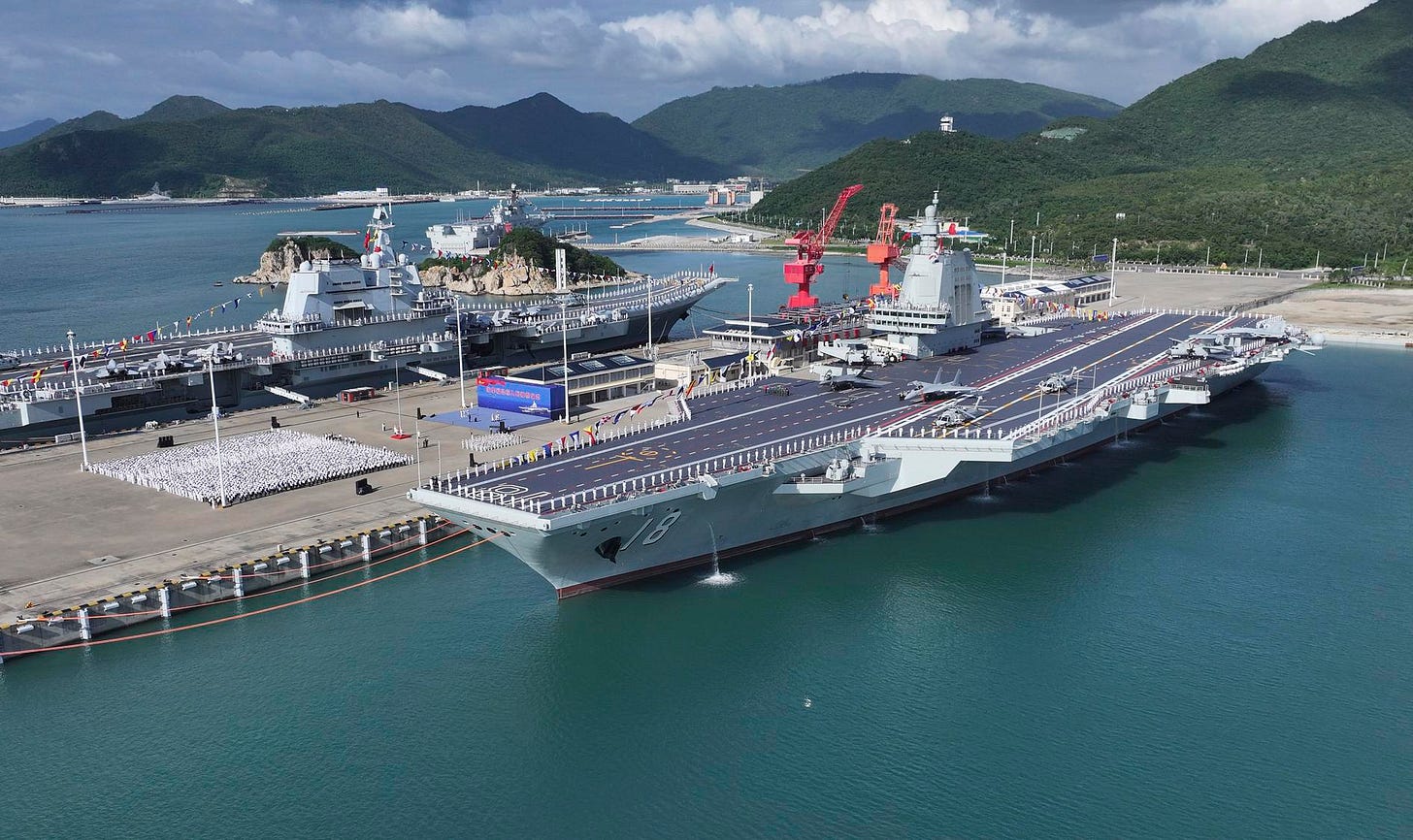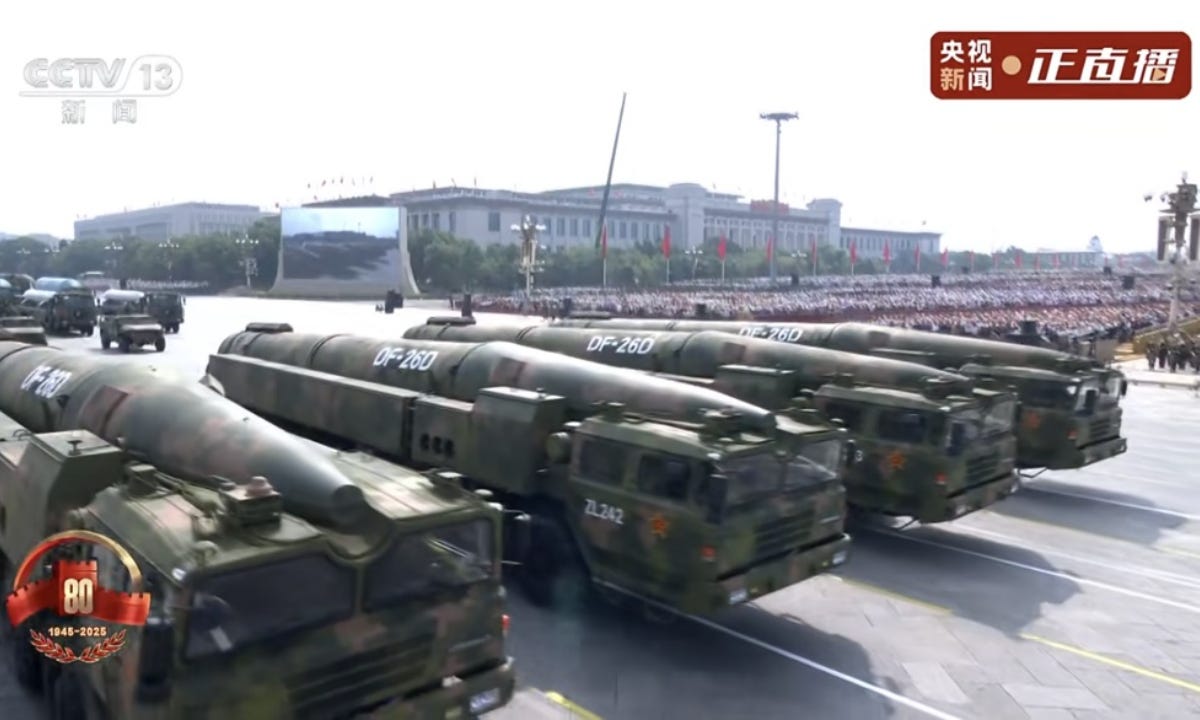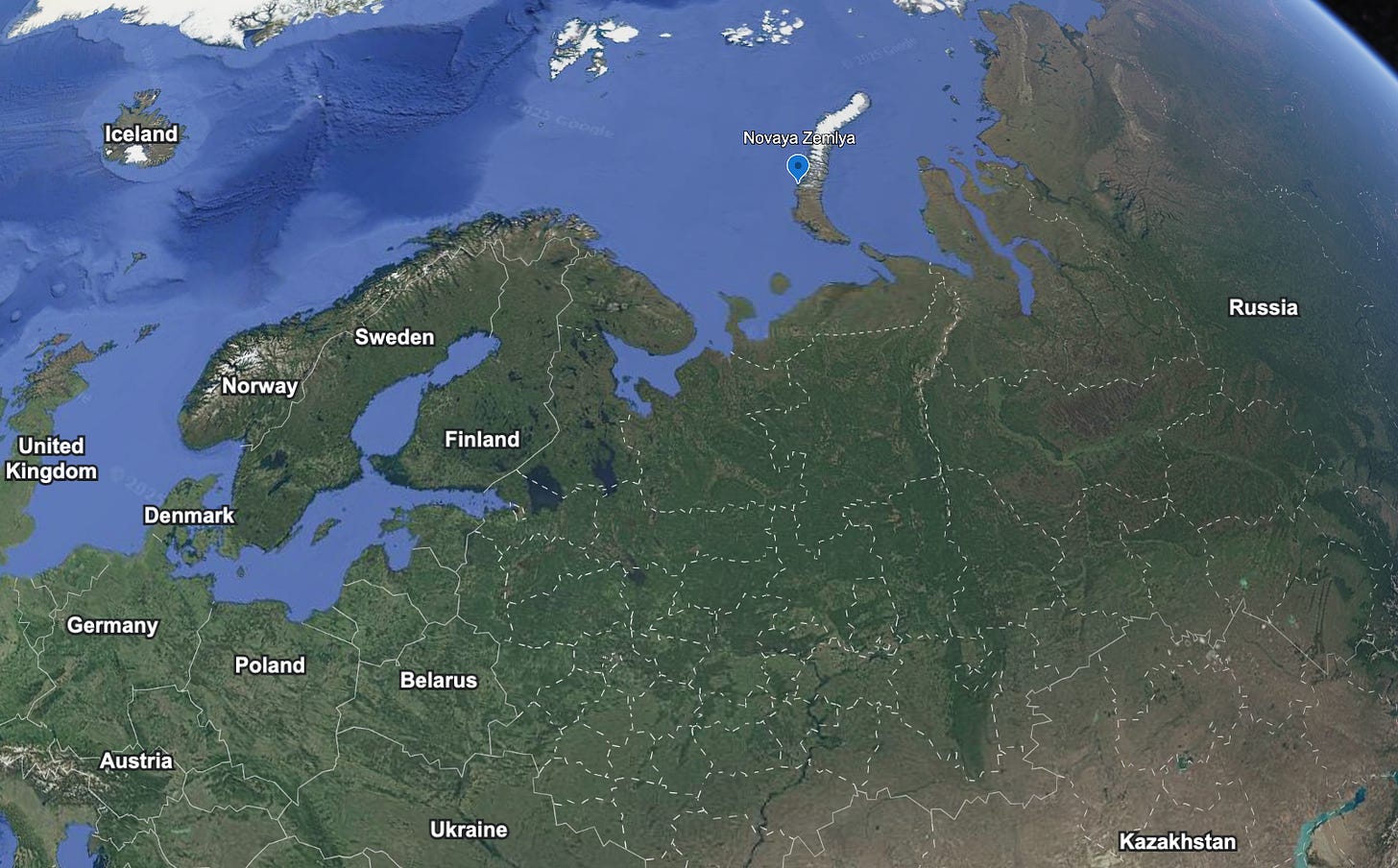Weekly Significant Activity Report - November 8, 2025
This week’s analysis highlights some of the most significant geopolitical developments involving America’s adversaries—China, Russia, Iran, and North Korea—between November 1 - November 8, 2025.
Summary:
Russia has announced plans to prepare for the resumption of nuclear weapons testing.
Despite official Kremlin denials, multiple signs suggest Russian Foreign Minister Sergei Lavrov may be losing favor with President Vladimir Putin.
Russian President Vladimir Putin signed into law two new bills aimed at increasing Russia’s capacity to conscript soldiers and to use military reservists in the war effort.
The Russian military launched one of its largest attacks on Ukraine’s energy infrastructure, disabling all Ukrainian state-owned thermal power plants.
Chinese President Xi Jinping officially commissioned China’s third and most advanced aircraft carrier, the Fujian.
A new CNN investigation found that China has significantly expanded its missile production over several years, with the pace accelerating after Russia’s invasion of Ukraine.
Severe drought in Iran has nearly depleted Tehran’s primary water source and threatens other Iranian cities.
US officials announced that Mexico thwarted an Iranian plot to assassinate Israel’s ambassador to the country earlier this summer.
South Korea’s National Intelligence Service reports that Kim Jong-un is prepared to resume diplomacy with the US while maintaining the capability to restart nuclear tests.
1. THE KREMLIN PROPOSES RESUMING NUCLEAR TESTING
On November 5, Russian Defense Minister Andrei Belousov called for Moscow to begin immediate preparations for “full-scale” nuclear testing. Belousov called for test sites to be prepared on the Arctic archipelago of Novaya Zemlya. Belousov’s suggestions were echoed by Chief of the Russian General Staff Valery Gerasimov.
President Vladimir Putin accepted Belousov and Gerasimov’s recommendations with a caveat. Putin assented to preparations for testing but stated that Russia would continue to adhere to the limitations on tests under the Comprehensive Nuclear Test Ban Treaty, while other parties continue to do so:
“I have noted some of your statements and opinions and would like to point out that Russia has always strictly adhered to its obligations under the Comprehensive Nuclear-Test-Ban Treaty, and we have no plans to deviate from these obligations.
At the same time, in fact, back in my Address to the Federal Assembly in 2023, I stated that if the United States or other states party to the relevant Treaty conduct such tests, then Russia too will have to take appropriate retaliatory measures.”
Takeaways:
The Kremlin’s announcement appears scripted to provide a pretext for Russia to resume nuclear testing regardless of US actions. Russian Defense Minister Belousov deliberately contextualized recent statements by President Donald Trump about resuming nuclear testing “on an equal basis” with Russia and China (which have since clarified to exclude actual nuclear explosions) as merely the latest in a series of steps the US has made toward modernizing its nuclear forces and undermining strategic stability. According to Belousov:
“We must certainly focus not only and not primarily on the statements and pronouncements of politicians and American officials, but above all on the actions of the United States of America. And these actions clearly demonstrate Washington’s active buildup of strategic offensive weapons.
“First, the White House has consistently withdrawn from long-standing arms reduction and limitation treaties: the ABM Treaty in 2002, the Intermediate-Range Nuclear Forces Treaty in 2019, and the Open Skies Treaty in 2020. Therefore, a potential US abandonment of the nuclear testing moratorium could be a logical step by Washington to undermine global strategic stability.
“Second, the United States is rapidly modernizing its strategic offensive weapons. Work is underway to develop a new intercontinental ballistic missile, the Sentinel, with a new nuclear warhead. Its range will be 13,000 kilometers. Work is underway on the prospective Columbia-class strategic nuclear submarine to replace the Ohio-class. A new B-21 Ryder heavy bomber is being developed. A cruise missile with a nuclear warhead is being developed, and so on. Fifty-six launchers on 14 Ohio-class submarines are scheduled to be decommissioned—I want to emphasize, decommissioned—and fully loaded with Trident II ballistic missiles. Preparatory work is underway to convert 30 B-52H strategic bombers back into nuclear carriers.
“Third, the Americans have begun implementing the Golden Dome program, which provides for both anti-missile interception and pre-launch destruction of Russian and Chinese missiles.
“Fourth, the United States Army plans to accept the new Dark Eagle medium-range missile system, armed with hypersonic missiles with a range of 5,500 kilometers, into service by the end of this year. This system is expected to be deployed in Europe and the Asia-Pacific region. The flight time from Germany, where this missile system is planned to be deployed, to targets in central Russia will be approximately six to seven minutes.
“Fifth, Washington regularly conducts strategic offensive force exercises. The most recent such exercise, Global Thunder 2025, which, I emphasize, focused on preemptive nuclear missile strikes against Russian territory, took place in October of this year.
“Generally speaking, this is a unified set of measures, including possible US plans to conduct nuclear tests, which significantly increase the level of military danger for Russia.”
This framing casts suspicion on US strategic force modernization (an effort Russia itself has undertaken and continues to pursue) suggesting Moscow is seeking justification for a decision it already wanted to make rather than responding to actual US policy changes.
Russia has regularly contrived pretexts for violating arms control treaties in order to derive strategic advantage and to pressure the US. The US withdrawal from arms control treaties with Russia that Belousov notes have often followed years of protests of Russian violations. Many of these alleged violations have been proven by subsequent events such as Russia’s use of Intermediate-Range Nuclear Forces Treaty (INF) Treaty violating missiles such as the Oreshnik medium-range ballistic missile and the SSC-8/9M729 cruise missile against Ukrainian cities.
Russia unilaterally withdrew its ratification of the Comprehensive Nuclear Test Ban Treaty (CTBT) in November 2023. At the time, the move, which was clearly designed to strike back at the US over its support for Ukraine, was predicated on the US’s own failure to ratify the treaty. However, analysts such as Nicole Grajewski of the Carnegie Endowment have pointed out that Russia was already suspected of conducting “subcritical” nuclear tests that violated the treaty’s provisions. These tests are believed to have occurred at Novaya Zemlya, the same site Belousov has now recommended be prepared for a “resumption” of testing and where Russia previously tested its experimental Burevestnik nuclear-powered, nuclear-armed cruise missile.
2. RUSSIAN FOREIGN MINISTER SERGEI LAVROV APPEARS TO LOSE FAVOR IN THE KREMLIN
On November 5, Kommersant reported that long-serving Russian Foreign Minister Sergei Lavrov was deliberately excluded from a Security Council meeting held that day in which the resumption of nuclear tests was proposed.
The reporting suggested that Lavrov’s “agreed upon absence” was the result of a loss of favor by Russian President Vladimir Putin. The strain between Lavrov and Putin allegedly stems from Lavrov’s October 20 phone call with US Secretary of State Marco Rubio. That phone call, which featured Lavrov reiterating maximalist demands to end the war in Ukraine, led to the cancelation of a proposed second summit between Trump and Putin in Budapest.
Kremlin spokesman Dmitry Peskov has since denied the suggestion that Lavrov has lost Putin’s confidence, and blamed Western and Ukrainian media for deceitful reporting.
Takeaways:
Peskov’s denial appears half-hearted as it was a prominent Russian publication—Kommersant—that originated the reporting on Lavrov’s deliberate absence from a high-profile Security Council meeting. The story itself appears to have been deliberately fed to the press to emphasize the event as well.

Origin of the reporting on Lavrov’s absence. Source: Kommersant It is difficult to assess with certainty what this reprimand (if it is that) means, however, there is some evidence to suggest that there are divergent views within the Kremlin about how to proceed with managing relations with the US, and Lavrov’s approach may be being marginalized.
President Putin has elevated Kirill Dmitriev, a Western-educated financier and head of the Russian Direct Investment Fund, to a special envoy position for negotiations with the US. This position has placed Dmitriev on a similar footing to Lavrov in diplomacy with the US, though Dmitriev has often focused efforts on building rapport with members of President Trump’s inner circle and his own special envoy Steve Witkoff.
There have been multiple reports that this competition for influence over Russia’s most important diplomatic negotiations in decades has contributed to feuding between Dmitriev and Lavrov.
It is notable that Lavrov’s failure to secure a second Trump-Putin summit was quickly followed by a visit by Dmitriev to New York and Florida to meet with Steve Witkoff and other Trump administration officials. This sequence of events suggests that the Kremlin dispatched Dmitriev to patch up relations with the administration after Lavrov’s phone call.
Even if there are divergent perspectives between Lavrov and Dmitriev in how to negotiate with the US, both are likely equally committed to achieving Russia’s maximalist war aims by convincing the US to drop its support for Ukraine.
3. RUSSIA PAVING THE WAY FOR FURTHER MILITARY MOBILIZATIONS
On November 4, Russian President Vladimir Putin signed into law two bills passed by the State Duma at the end of October expanding the scope of Russia’s military conscription and its use of reservists. The first bill authorizes year-round conduct of military conscription. The second bill authorizes the mobilization of reservists for the protection of oil refineries and other critical infrastructure.
Takeaways:
The new bill authorizing year-round conscription will not entirely change Russian military conscription. Conscripts will still be entered into military training during the same spring and fall cycles. Rather the new bill will allow recruitment to run continuously in order to better process exemptions and other administrative work.
The bill authorizing the call up of reservists to protect against drones is part of an effort to stem the onslaught of Ukrainian attacks which have severely damaged Russia’s oil refining capacity. While having greater numbers of troops to provide local security will increase the probability of intercepting Ukrainian drones, it is not clear by how much. Russia faces a shortage of sophisticated air defense systems to cover its frontline military positions and protect the critical infrastructure widely dispersed across its vast territory.
Neither bill will immediately impact the war effort, but both are significant in signaling the Kremlin’s intent to lay the groundwork for a future partial or full military mobilization.
4. RUSSIA’S TARGETING OF UKRAINIAN ENERGY INFRASTRUCTURE INTENSIFIES
Russia launched as many as 500 drones and missiles at Ukrainian energy infrastructure in waves of attacks between November 7-8. The overnight attacks, characterized by Ukraine’s state-owned energy company Centrenergo as the “largest ever,” disabled all the company’s thermal power plants.
Takeaways:
Russian attacks on Ukraine’s power grid and power plants have accelerated since early October. It is the latest in what has become an annual attempt by the Kremlin to plunge Ukrainian cities into darkness and cold ahead of winter to degrade civilian morale.
While the destruction of Ukraine’s state-owned thermal power plants represents a setback for the country’s energy sector, many of these facilities had only recently been restored following Russian attacks in 2024. As a result the plants were not serving as a critical node in Ukraine’s energy infrastructure.
The critical component of Ukraine’s power grid is arguably no longer even in the country for Russia to strike. Ukraine has diversified its energy supply and now imports the majority of its power from European producers. This diversification makes it difficult for Russia to land a true knockout blow on the energy Ukraine needs to continue its war effort.
Current strikes will however lead to outages that could become prolonged and worsen the quality of life for Ukrainian civilians. The damage will also increase Ukraine’s need for foreign assistance at a time when such support has become more uncertain, given declining US interest and concerns among EU members about securing adequate funding.
5. CHINA COMMISSIONS ITS MOST ADVANCED AIRCRAFT CARRIER
On November 7 Chinese President Xi Jinping officially commissioned China’s third, and most advanced aircraft carrier, the Fujian. The Fujian will be officially based at the Yulin Naval Base near the city of Sanya on the southern tip of Hainan.

Takeaways:
The Fujian will be the second aircraft carrier stationed at Yulin. The base is also home to China’s first carrier the Liaoning.
Yulin is China’s most advanced naval base.1 The base has been under construction for over 20 years at an estimated cost of more than $50B. In addition to two carriers, Yulin is believed to be home to the bulk of China’s most advanced submarines—the Type 094 (Jin-class) nuclear-powered ballistic missile submarines. The base allows China to project power into the South China Sea and exert control over regional trade routes.
Xi’s emphasis on developing Hainan into a specially designated Free Trade Port, means that Yulin will continue to grow in importance and may become the most strategically important naval base in the world.
Xinhua’s press release for the event included a hidden dig at President Donald Trump.
“It was Xi’s decision that the Fujian adopt the electromagnetic catapult system. On Wednesday, he visited the control area of this system and attentively observed the operational procedures.”
The seemingly harmless remark appears to mock Trump’s October 30 declaration that he will issue a future executive order requiring US aircraft carriers to abandon electromagnetic catapults for less sophisticated steam launch systems.
6. CHINA’S ROCKET FORCE EXPANDING RAPIDLY
On November 6, CNN published the results of an investigation into the expansion of China’s missile production.
CNN investigators found that 60% of the 136 estimated sites responsible for manufacturing components of Chinese missiles have grown in size since 2020, amounting to 21M square feet of additional floor space. A site believed responsible for producing the DongFeng-26 missile, one of China’s most advanced, capable of launching hypersonic glide vehicles has grown more than 50% in the past five years.

The growth in Chinese missile production appears to have accelerated since Russia invaded Ukraine in 2022.
Takeaways:
As noted in the CNN investigation, China appears to be rapidly expanding its missile production in response to lessons learned from Russia’s failures in Ukraine. The Russian military has been forced to significantly scale up production of long-range drones and missiles as the conflict progressed. This may have prompted Beijing to reassess previous estimates of the number of munitions it will need for a potential conflict over Taiwan or a broader confrontation with the United States.
Missiles and long-range drones will be even more important weapons in any conflict between China and the US in the Indo-Pacific than in the current war in Ukraine. The People’s Liberation Army will have to strike numerous distant US bases across both the first and second island chain in order to curb US air and naval power.
US air defense systems have demonstrated exceptional effectiveness in shooting down Russian drones and missiles in Ukraine and in defending Israel, Qatar and the US’s other Middle Eastern allies against aerial attacks from Iran and the Houthis in Yemen. This may have led China to conclude it needs far greater numbers of missiles to effectively strike and neutralize US bases.
7. IRANIAN WATER CRISIS INTENSIFIES
This week Iranian officials reported that the Amir Kabir reservoir—Tehran’s main source of water—is at 8% of its total capacity. The reservoir can provide less than two weeks worth of water to Tehran at this level. 19 other major Iranian reservoirs are also below 20% capacity.
The shortages have led Tehran to begin implementing night-time rationing of water. Iranian President Masoud Pezeshkian warned on November 6 that further rationing and even a potential evacuation of the city may be necessary if the drought continues.
Takeaways:
The water crisis, while blamed on a lack of rainfall, results from a combination of both climate and human factors, including a mismanagement of Iranian natural resources and over urbanization in unsuitable regions.
Even if Tehran and other Iranian cities weather the current crisis, long-term climate trends will necessitate internal migration. As noted in the Weekly Significant Activity Report - October 4, Iranian President Masoud Pezeshkian has stated that water shortages in Tehran have no long-term solution and that the Iranian capital will inevitably have to be relocated to the south toward the Persian/Arabian Gulf at some point in the future.
The water crisis adds to mounting societal stresses facing Iran that are equally difficult to resolve without major reforms the regime appears unwilling to make. Some Iranian officials have expressed concern that it is a matter of time before a renewed wave of civil unrest resumes. The period of greatest danger for Iranian officials is likely to come during the succession of Ayatollah Ali Khamenei. Khamenei will turn 87 in April and does not yet have a clear successor. This political uncertainty sets the stage for a potential crisis that emboldens public opposition to the regime.
8. IRAN ATTEMPTED TO ASSASSINATE ISRAEL’S AMBASSADOR TO MEXICO
This week US officials announced that Unit 11000 of the elite Quds Force of the Iranian Revolutionary Guard Corps plotted to assassinate Israel’s Ambassador to Mexico earlier this year. The months long plot was stopped by Mexican security forces during the summer.
Takeaways:
As part of the announcement US officials revealed that Iran’s Embassy in Venezuela served as headquarters for planning the attacks. The timing of this week’s announcement likely reflects an interest in increasing pressure on Venezuelan President Nicolas Maduro, by tying him to Iran’s state-supported terrorism network. However, Iranian special operations forces and proxy fighters have long been known to operate in Venezuela.
A March 2013 hearing before the House Foreign Affairs Committee alleged that members of the Quds Force and Hezbollah have operated in Venezuela since the early 2000’s during the presidency of Hugo Chavez. Both groups have used their operations in the country to engage in money laundering and drug trafficking, and to plot attacks on Jews and Israeli interests in Latin America.
According to Israel’s Mossad national intelligence agency, Unit 11000 has been involved in numerous plots to attack Jews and Israeli, including foiled attacks in Europe and Australia over the past year.
9. NORTH KOREA SIGNALING READINESS TO RESTART TALKS WITH THE US AND POTENTIALLY RESUME NUCLEAR TESTS
Kim Jong-un Ready for Summit with President Trump
South Korea’s National Intelligence Service (NIS) reported this week during a closed door hearing of the South Korean parliament that it has seen signs North Korea is preparing for a possible future summit between President Trump and Kim Jong-un.
The NIS assessed that “Kim Jong-un has the will for dialogue with the US and will engage with the US once conditions are met.”
North Korea Prepared to Resume Nuclear Tests
The NIS also assesses that North Korea is prepared to conduct a seventh nuclear test. The NIS stressed that Kim Jong-un has not yet made a decision to resume testing. Any future test would be conducted underground at the Punggye-ri Nuclear Test Site.
Takeaways:
The North may be using recent missile and rocket launches as a means of getting the US’s attention to resume talks.
The primary condition holding back US-North Korea dialogue is the North’s insistence that the US end its policy of denuclearization and recognize its status as a nuclear power.
Kim may be hoping that Trump, known for his willingness to buck convention (including in previous talks with Pyongyang), will see the North’s nuclear development as irreversible and be willing to make some pragmatic concessions to secure dialogue and calm on the Korean peninsula. This is not an unreasonable expectation. Trump has given suggestions early in his term that he holds this view, and as recently as October 25, described North Korea as “sort of a nuclear power.”
Kim may assume that any US recognition of North Korea’s nuclear program would be difficult to reverse and could lead to a long-term shift in US posture. However, US policy has proven resilient. The White House has repeatedly walked back remarks by President Trump implying recognition of North Korea’s nuclear program in response to concerns from South Korea.
The North may be willing to resume nuclear testing if the US refuses to budge on its demands for denuclearization. A resumption of nuclear testing by either the US or Russia may also push the North to reciprocate as well.
Yulin Naval Base is actually a combination of a few different ports. The submarine piers are located at a separate bay in an area known as Yulin East, several kilometers away from the docks for the Fujian and Liaoning.




